
Sextuple star system fascinates with three eclipsing binaries
An international team of researchers led by Brian P. Powell at NASA's Goddard Space Flight Center and Veselin P. Kostov at the SETI Institute has identified a unique system consisting of six stars. The three binary stars form a gravitationally-bound system, and each pair is producing eclipses. The star system, known as TYC 7037-89-1, was uncovered in data from the Transiting Exoplanet Survey Satellite (TESS) data with a neural network designed to detect eclipsing binary stars. This newly discovered complex star system is located in the Eridanus constellation, ~1,900 light-years away from Earth.
“Multiply-eclipsing multiple systems such as TYC 7037-89-1 enable simultaneous, precise measurements on the stellar sizes, temperatures, and potentially masses, of pairs of stars that share common history,” said Kostov, a research scientist at the SETI Institute. “In turn, this provides better understanding of stellar formation and evolution in dynamically-rich environments.” (Astronomy Now)
Machine learning played a critical role in this discovery by sifting through millions of records.
…Powell, working with Veselin Kostov, an astrophysicist at the SETI Institute, designed a neural network that could identify eclipsing binary stars using TESS data.
The neural network studied an archive of nearly 80 million records of light-intensity changes, way more than humans alone could handle. “What machine learning can do is take this intractable data set and turn it into something a human can work with,” Powell said. (WRAL.com)
- Astronomy Now: Sextuple star system fascinates with three eclipsing binaries
- WRAL.com: Six Stars, Six Eclipses: ‘The Fact That It Exists Blows My Mind’
- SETI.org: Sextuply-Eclipsing Sextuple Star System Uncovered in TESS Data with an Assist from AI
- SETI Live: Sextuply-Eclipsing Sextuple Star System -- WHAT?
NASA Selects Proposals to Help Learners of All Ages ‘Do’ Science
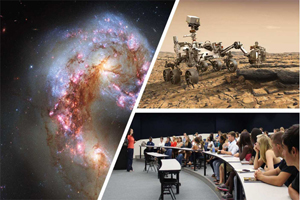 The SETI Institute is one of nine recent awardees for NASA’s Science Activation Program (SciAct). The NASA Community College Network (NCCN), led by Simon Steel of the SETI Institute, will connect community college students with leading space science education initiatives.
The SETI Institute is one of nine recent awardees for NASA’s Science Activation Program (SciAct). The NASA Community College Network (NCCN), led by Simon Steel of the SETI Institute, will connect community college students with leading space science education initiatives.
The NCCN will bring NASA science subject matter experts and NASA science resources into the classrooms of the nation’s community college system. Principal Investigator: Simon Steel at the SETI Institute in Mountain View, California (NASA.gov)
Tour: Inside R&D Startup and NASA Contractor – Impossible Sensing
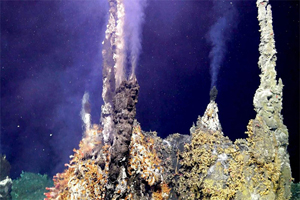 Join SETI Institute research scientist and Impossible Sensing founder Pablo Sobron for a SolidSmack tour and peek inside Impossible Sensing, an R&D startup and NASA contractor that develops optical sensors to explore a wide variety of extreme environments. Devices like InVADER (In-situ Vent Analysis Divebot for Exobiology Research), expected to begin deep ocean monitoring in July 2021, are designed to detect and monitor matter and materials associated with life.
Join SETI Institute research scientist and Impossible Sensing founder Pablo Sobron for a SolidSmack tour and peek inside Impossible Sensing, an R&D startup and NASA contractor that develops optical sensors to explore a wide variety of extreme environments. Devices like InVADER (In-situ Vent Analysis Divebot for Exobiology Research), expected to begin deep ocean monitoring in July 2021, are designed to detect and monitor matter and materials associated with life.
Impossible Sensing’s grander vision is to build instruments that will detect evidence of life on Mars and beyond. Projects for monitoring life on the ocean floor are great starter endeavors. (Before It’s News)
- Before It’s News: Tour: Inside R&D Startup and NASA Contractor – Impossible Sensing
- SETI.org: InVADER Project to send a Robotic Laser to Explore Deep Sea Vents
- InVADER-mission.org: Exploring Hydrothermal Systems
Mars’ ‘Happy Face’ crater has grown in a decade due to thermal erosion
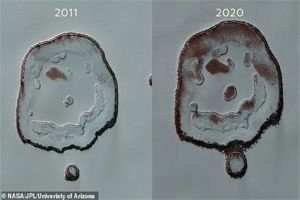 Researchers have noticed that the ‘Happy Face” crater near the south pole of Mars now has an even bigger smile and nose, based on images taken by the High-Resolution Imaging Science Experiment (HiRISE) camera on NASA’s Mars Reconnaissance Orbiter nine years ago. The changes in size may result from thermal erosion, a process where carbon dioxide evaporates, exposing more soil.
Researchers have noticed that the ‘Happy Face” crater near the south pole of Mars now has an even bigger smile and nose, based on images taken by the High-Resolution Imaging Science Experiment (HiRISE) camera on NASA’s Mars Reconnaissance Orbiter nine years ago. The changes in size may result from thermal erosion, a process where carbon dioxide evaporates, exposing more soil.
‘You can see how nine years of this thermal erosion have made the ‘mouth’ of the face larger,’ said Ross Beyer, a planetary scientist with the Sagan Center at the SETI Institute.
The ‘face’ also got something of a nose job: At first it consisted of two circular depressions.
But by 2020, ‘those two depressions have grown larger and merged,’ Beyer pointed out. (Newsfeeds.Media)
- Newsfeeds.Media: Mars’ ‘Happy Face’ crater has grown in decade due to thermal erosion
A $100 Million Message From Aliens Next-Door? What We Know About The Mysterious ‘BLC1’ Radio Signal
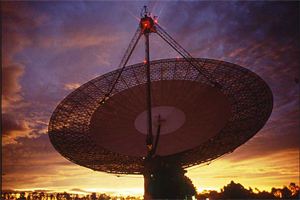 Experts continue to speculate about the nature of BLC1 (Breakthrough Listen Candidate 1), a yet-to-be-identified signal potentially originating from the red dwarf star Proxima Centauri or one of its exoplanets.
Experts continue to speculate about the nature of BLC1 (Breakthrough Listen Candidate 1), a yet-to-be-identified signal potentially originating from the red dwarf star Proxima Centauri or one of its exoplanets.
“Of the 300 million exoplanets that could be habitable in our galaxy, which is 200,000 light years across, it would be an astonishing coincidence for two civilizations—ours and one on Proxima b or c—to be using the same technology at the same time,” said Franck Marchis, a Senior Planetary Astronomer at the SETI Institute.
Marchis suspects a down-to-earth explanation for the signal’s origin. “It’s probably not alien and we will confirm this soon (but) nothing would please me more than to be proven wrong.” (Forbes)
- Forbes: A $100 Million Message From Aliens Next-Door? What We Know About The Mysterious ‘BLC1’ Radio Signal
- Universe Today: According to the Math, it’s Highly Unlikely That an Intelligent Civilization is Located at Alpha Centauri
- SETI.org: Did Proxima Centauri Just Call to Say Hello? Not Really!
- SETI.org: A Signal from Proxima Centauri?
A plan to beam a musical message to other planets
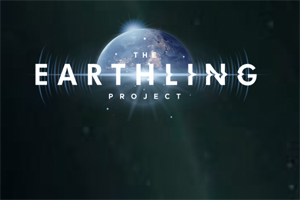 Launched in December 2020, the Earthling Project is a collaborative effort between SETI Institute Artist-in-Residence Felipe Pérez Santiago, SETI Institute co-founder Dr. Jill Tarter and the Arch Mission Foundation. Felipe Pérez Santiago plans to create original music compositions with song snippets gathered globally through an app and send them into space.
Launched in December 2020, the Earthling Project is a collaborative effort between SETI Institute Artist-in-Residence Felipe Pérez Santiago, SETI Institute co-founder Dr. Jill Tarter and the Arch Mission Foundation. Felipe Pérez Santiago plans to create original music compositions with song snippets gathered globally through an app and send them into space.
“The Earthling Project consists of gathering human voices from all over the world to create global online compositions and send them into space as a representation of our species united as one, having our first mission to the moon in 2021,” said Pérez Santiago. (SETI.org)
… for the first time, SETI is cocking its ear towards Earth.
It is looking for the same thing on this planet that it routinely seeks from others: a signal that can be beamed into space to represent the species. (The Economist)
- The Economist: A plan to beam a musical message to other planets
- ArtsJournal: Beaming Music To Potential Extraterrestrial Life
- SETI.org: Earthling Project Launches
Asteroid naming contest sparks discussion of women in astronomy
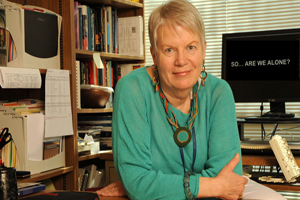 Unistellar and the SETI Institute recently teamed up for a contest to name an asteroid. The contest winner, the late astronomer Ada Amelia Carrera Rodriguez, was also celebrated for her accomplishments in the field as part of a tribute and recognition of an increasing number of women in astronomy.
Unistellar and the SETI Institute recently teamed up for a contest to name an asteroid. The contest winner, the late astronomer Ada Amelia Carrera Rodriguez, was also celebrated for her accomplishments in the field as part of a tribute and recognition of an increasing number of women in astronomy.
In a joint project, the SETI Institute and the company Unistellar sponsored a “Name the Asteroid” contest in late 2020 for near-Earth asteroid 1999 AP10, also known as Asteroid 159402, which drew over 120 entries.
At Unistellar‘s Winter Solstice Virtual Star Party on Dec. 21, 2020, the company announced Carrera, a Mexican astronomer, who died earlier that year at age 84, as the contest winner.
Her selection was celebrated in an online discussion on Jan. 13, 2021, titled “Women in Astronomy,” which promoted awareness of Carrera and her accomplishments and recognized the growing number of women in the field. (Spaceflight Insider)
- Spaceflight Insider: Asteroid naming contest sparks discussion of women in astronomy
Big Picture Science
Skeptic Check: Shared Reality One of the many shocking aspects of the Capitol attack was that it revealed how thoroughly the nation had cleaved into alternate realities. How did we get to this point? How did misinformation come to create beliefs embraced by millions?
One of the many shocking aspects of the Capitol attack was that it revealed how thoroughly the nation had cleaved into alternate realities. How did we get to this point? How did misinformation come to create beliefs embraced by millions?
In this episode, experts in social media, cults, and the history of science join us for a discussion about how these alternative realities formed, why people are drawn to them, and the benefits of a shared reality.
Join guests Joan Donovan, Lee McIntyre and Steven Hassen for a discussion and look at the many aspects of alternative realities in Skeptic Check: Shared Reality.
Supercomputer Showdown Do you have a hard-to-answer question? The Summit, Sierra, Trinity, Frontier, and Aurora supercomputers are built to tackle it. Summit tops the petaflop heap – at least for now. But Frontier and Aurora are catching up as they take aim at a new performance benchmark called exascale.
Do you have a hard-to-answer question? The Summit, Sierra, Trinity, Frontier, and Aurora supercomputers are built to tackle it. Summit tops the petaflop heap – at least for now. But Frontier and Aurora are catching up as they take aim at a new performance benchmark called exascale.
So why do we need all this processing power? From climate modeling to personalized medicine, find out why the super-est computers are necessary to answer our biggest questions. But is the dark horse candidate, quantum computing, destined to leave classical computing in the dust?
Join guests Katherine Riley, Jack Wells, Katie Bethea, Jeffrey Hawkins and Eleanor Rieffel for a look at supercomputers, why they are helpful and where they are headed in Supercomputer Showdown.
For more information and the archive of past shows, visit the Big Picture Science website.
SETI Live
Recent SETI Live episodes include:
Where should we look for ET?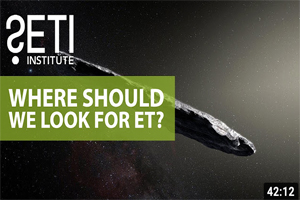 Finding intelligence in the cosmos might be done simply by paying attention. While SETI scientists look for radio or optical signals, the astronomy community is perennially on the lookout for all types of cosmic phenomena. One example of the latter is the discovery, three years ago, of what was thought to be a previously unknown asteroid. While asteroids are enormously commonplace in our solar system, this object, christened Oumuamua, is clearly from someone else’s solar system. Harvard astronomer Avi Loeb has suggested that Oumuamua might not be an asteroid at all, but a type of interstellar craft, sent our way by extraterrestrials. Why does he think this, and what is the larger lesson we should heed in our search for alien intelligence?
Finding intelligence in the cosmos might be done simply by paying attention. While SETI scientists look for radio or optical signals, the astronomy community is perennially on the lookout for all types of cosmic phenomena. One example of the latter is the discovery, three years ago, of what was thought to be a previously unknown asteroid. While asteroids are enormously commonplace in our solar system, this object, christened Oumuamua, is clearly from someone else’s solar system. Harvard astronomer Avi Loeb has suggested that Oumuamua might not be an asteroid at all, but a type of interstellar craft, sent our way by extraterrestrials. Why does he think this, and what is the larger lesson we should heed in our search for alien intelligence?
The Museum of Alien Life Explained 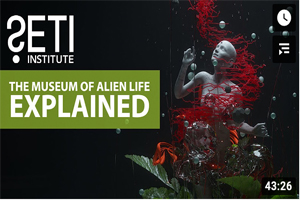 What if there was a museum that contained every type of life form in the universe? A place that includes the possible forms alien life might take, from the eerily familiar to the utterly exotic, ranging from the inside of the Earth to the most hostile corners of the universe. This place does not yet exist but it has been digitally created by Melodysheep. Join us on Wednesday Jan. 20 at 10am PST for a special SETI Live with John D. Boswell, aka Melodysheep, a filmmaker, composer, VFX artist, known for his YouTube series named Life Beyond. John will sit down with SETI Institute Senior Astronomer, Franck Marchis, to discuss his recent video named the Museum of Alien Life which already had 7.3 million views on YouTube. John will explain the motivation for this video, the science behind it, the process to make it, and of course the creative content.
What if there was a museum that contained every type of life form in the universe? A place that includes the possible forms alien life might take, from the eerily familiar to the utterly exotic, ranging from the inside of the Earth to the most hostile corners of the universe. This place does not yet exist but it has been digitally created by Melodysheep. Join us on Wednesday Jan. 20 at 10am PST for a special SETI Live with John D. Boswell, aka Melodysheep, a filmmaker, composer, VFX artist, known for his YouTube series named Life Beyond. John will sit down with SETI Institute Senior Astronomer, Franck Marchis, to discuss his recent video named the Museum of Alien Life which already had 7.3 million views on YouTube. John will explain the motivation for this video, the science behind it, the process to make it, and of course the creative content.
As always, videos of all past Facebook Live events can be found on our Facebook page: https://www.facebook.com/SETIInstitute/
Or on our YouTube channel: https://www.youtube.com/SETIInstitute





